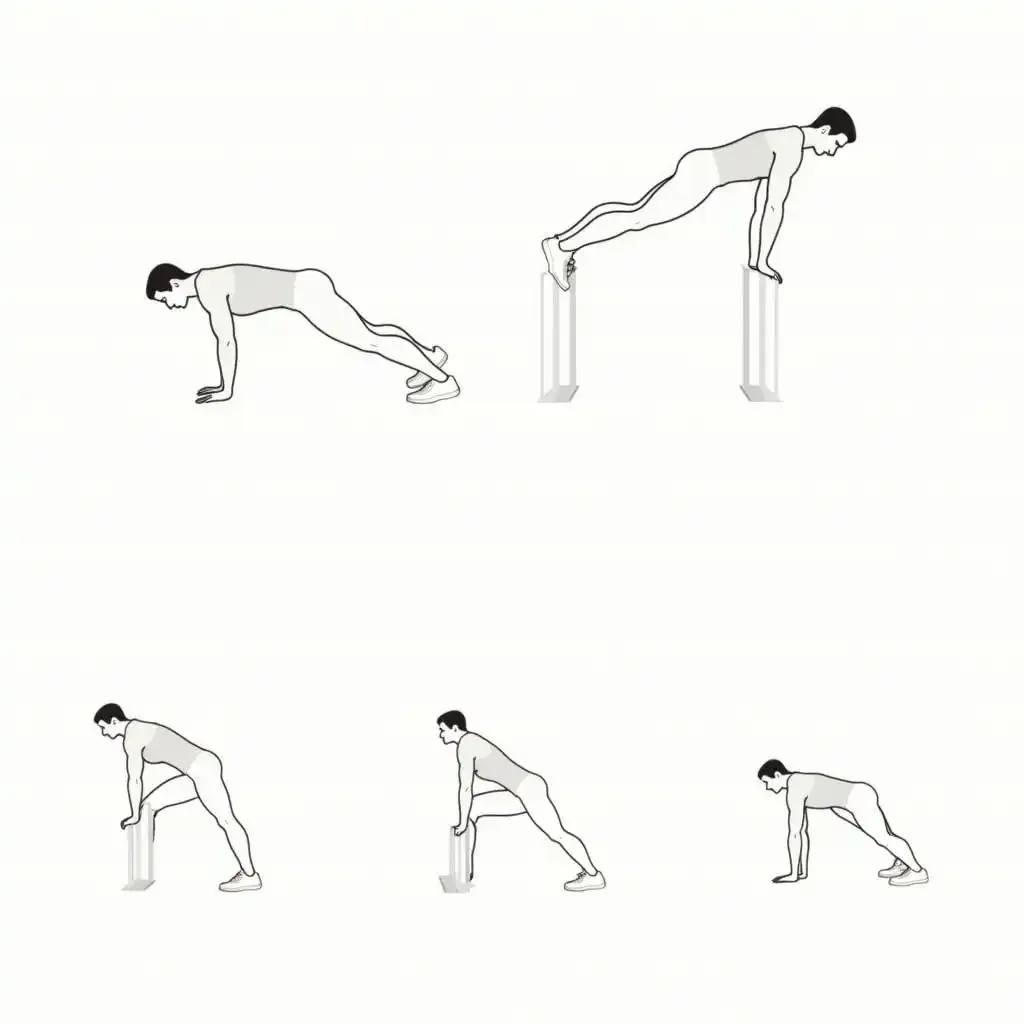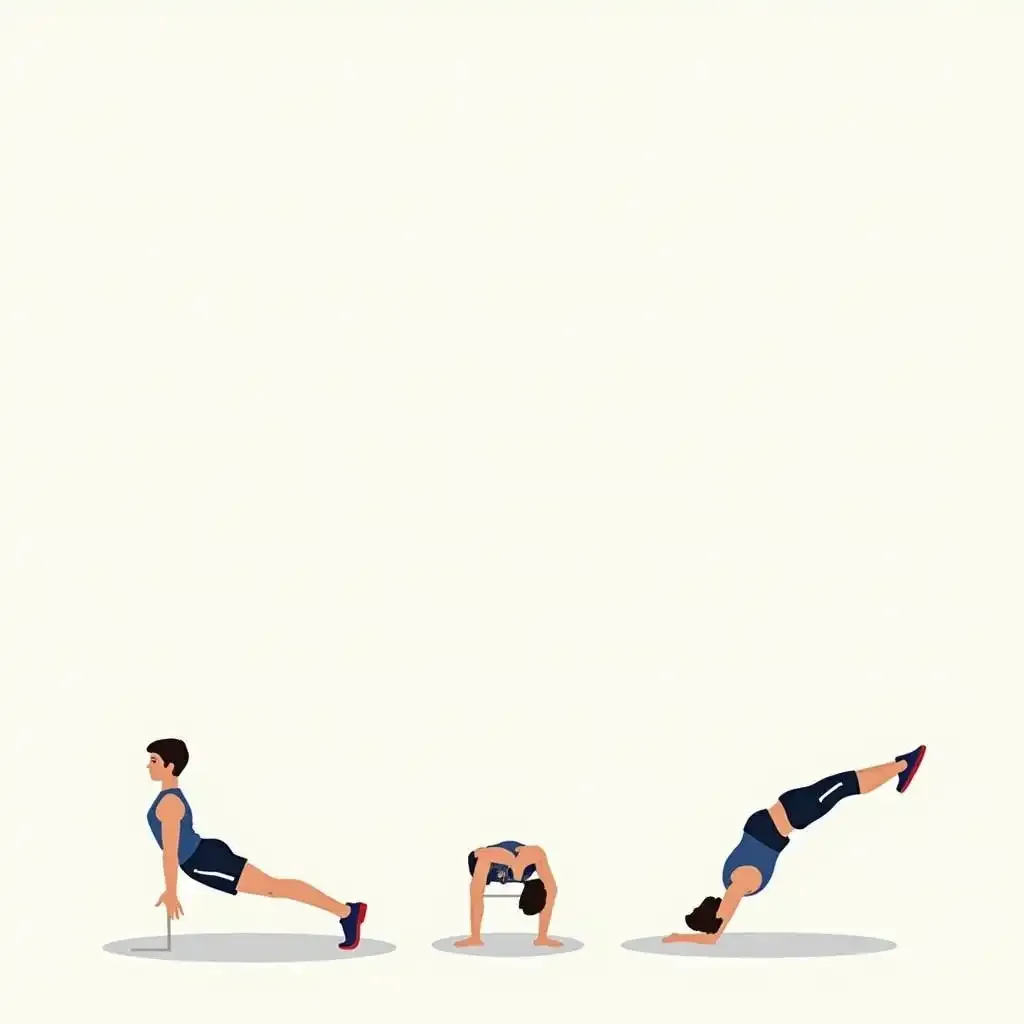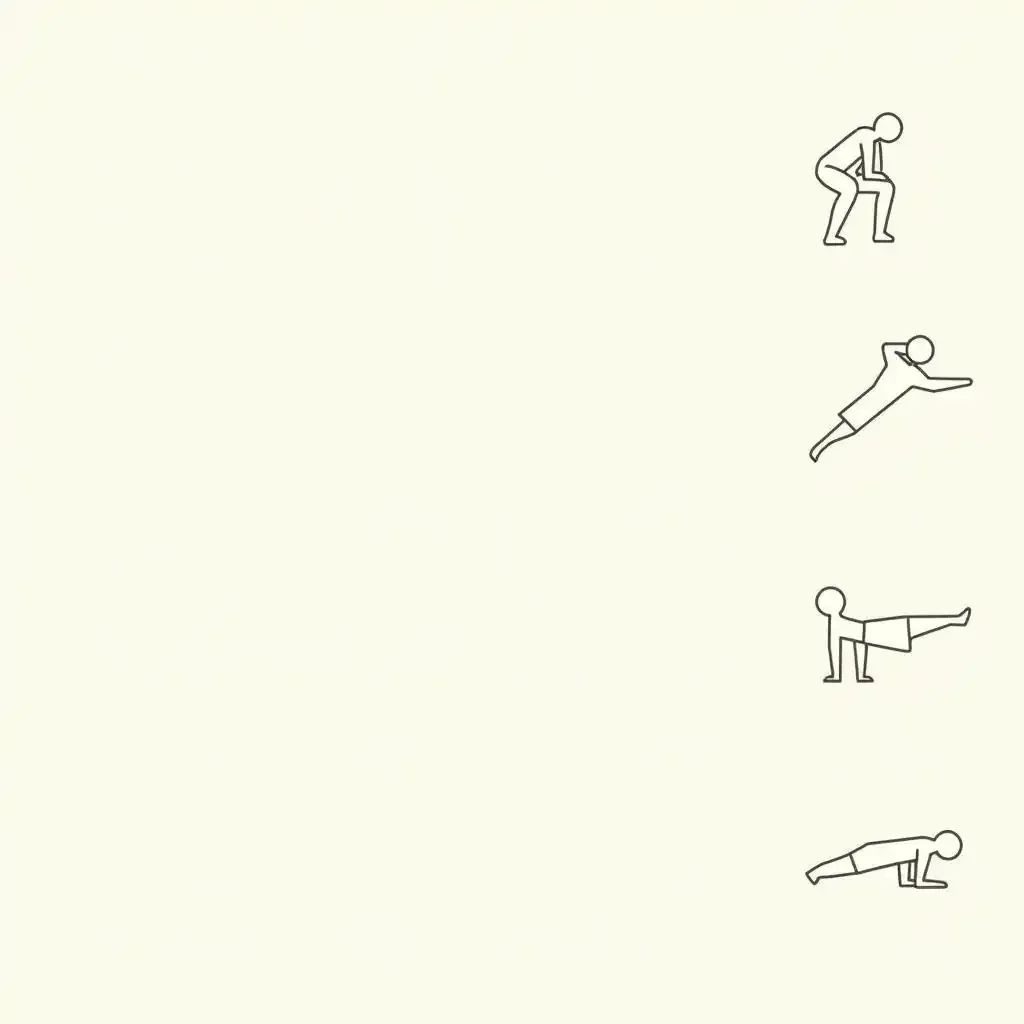Table of Contents
Hey there, fitness fanatics and couch potatoes alike! Welcome to kizworld, your one-stop shop for all things fitness. Today, we're diving headfirst into the amazing world of body weight exercises – the secret weapon for building strength, boosting endurance, and sculpting a killer physique, all without needing a single piece of fancy gym equipment. Think you need expensive machines or complicated routines? Think again! Body weight exercises are incredibly versatile, effective, and accessible to everyone, regardless of your fitness level. Whether you're a complete beginner looking to get started or a seasoned athlete aiming to level up your workouts, this article will equip you with the knowledge and inspiration you need to begin on your body weight fitness process. We’ll cover everything from basic exercises to advanced moves, providing you with clear instructions, helpful tips, and a few laughs along the way. So, ditch the excuses, get ready to sweat, and let’s get started!
Key Takeaway | Details |
|---|---|
Benefits of Body Weight Exercises | Improved strength, endurance, flexibility, balance, and overall fitness. Works your entire body. |
Effectiveness | Builds muscle mass without external weights; highly adaptable to different fitness levels. |
Examples of Exercises | Push-ups, squats, lunges, planks, burpees, and many more variations. |
Tips for Success | Start slowly, focus on proper form, mix up exercises, listen to your body, and stay consistent. |
Where to Do Them | Anywhere, anytime! Home, park, gym – the choice is yours. |
Awesome Body Weight Exercises: Build Strength Now!
Body Weight Exercises: A Beginner's Guide
Getting Started: Your First Steps into Calisthenics
Hey there, future fitness rockstar! So, you're thinking about jumping into the world of body weight exercises? Awesome! It's like discovering a secret superpower – you're building strength and endurance using just your own body. Think of it like this: you’re training your body to be its own personal weight machine. No fancy equipment needed, just you and your amazing body. I started with simple exercises, like squats and push-ups against a wall. Remember, consistency is key; even a few minutes a day makes a big difference. And guess what? You can do these workouts anywhere, anytime! My living room floor became my personal gym. If you’re feeling a bit unsure, check out our guide on does calisthenics work? It will really help clear up any doubts!
Exercise | Sets | Reps | Rest |
|---|---|---|---|
Wall Push-ups | 3 | 10-12 | 30 seconds |
Squats | 3 | 10-15 | 30 seconds |
Plank | 3 | 30-60 seconds | 30 seconds |
Building a Solid Foundation: Mastering the Basics
Once you've got the hang of the basics, it's time to level up! Think of your body like a finely tuned machine. It needs a variety of movements to work properly. Start incorporating different variations of squats – try adding lunges to work on your balance and leg strength. Want to make your push-ups more challenging? Try doing them on your knees, or maybe even try incline push-ups. Remember, proper form is super important! It's better to do fewer reps with perfect form than tons of sloppy ones. It's all about quality over quantity. Remember, Rome wasn't built in a day, and neither is a super-fit body! For more detailed guides, you might want to check out our calisthenics workouts page. It is full of helpful tips.
- Focus on proper form to avoid injuries.
- Listen to your body and take rest days when needed.
- Gradually increase the difficulty of exercises as you get stronger.
Listen to Your Body: Rest and Recovery
I know, I know – you're super excited to build those muscles, but it's important to remember that rest is just as crucial as the workouts themselves! Your body needs time to recover and rebuild stronger. Think of your muscles like little superheroes – they need time to recharge after battling gravity and resistance. Rest days are your chance to let your muscles recover and prepare for the next challenge. And guess what? Rest days don’t mean doing absolutely nothing! Gentle stretches or a relaxing walk can help improve your recovery time. Remember, there is no shame in taking a break; in fact, it is a sign of smart training. Want to learn more about how often to train? Check out our article on how often should you do calisthenics? for a deeper understanding.
"The body achieves what the mind believes." - Napoleon Hill
Mastering Body Weight Exercises: Form and Technique
Okay, so you've conquered the basics – congrats! Now, let's talk about *really* mastering these body weight exercises. Think of it like learning to ride a bike; at first, you wobble, maybe even fall a few times. But with practice, you become smooth, graceful, and even start doing tricks! It's all about nailing the right form. This isn't just about getting the reps done; it's about building strength *safely* and avoiding injuries. I learned that the hard way – once, I tried to do a push-up with terrible form, and ended up with a sore shoulder for days!
- Engage your core: This is your body's superpower center. Think of it as your inner superhero, keeping you stable and strong. Imagine tightening your belly button towards your spine.
- Maintain proper posture: Keep your back straight, shoulders down, and chin up. It’s like standing tall and proud, ready to conquer the world (or at least, your workout).
- Control the movement: Don't rush through the exercises. Slow and controlled movements are key. Focus on each muscle working, feeling the burn.
Let's take push-ups as an example. Many beginners struggle with these, but there are ways to make them easier. Start with knee push-ups, gradually working your way up to full push-ups. You can also adjust the angle of your body by doing incline push-ups against a wall or a bench. As you get stronger, you can try different variations like decline push-ups or even plyometric push-ups (those explosive ones where you clap your hands!). Remember, consistency is key! Even small improvements each day add up to big results. For a more detailed guide on how to perfect your push-ups, check out our guide on .
Exercise | Focus Point | Tip |
|---|---|---|
Push-ups | Core engagement | Engage your core throughout the movement. |
Squats | Proper posture | Keep your back straight and chest up. |
Lunges | Controlled movement | Lower your body slowly and steadily. |
Another crucial aspect is listening to your body. Pain is not your friend! If something feels wrong, stop immediately. You might just need to modify the exercise or take a rest day. Remember, progress isn't always linear. There will be days when you feel stronger, and days when you might feel a bit weaker. That's perfectly normal! This is like a marathon, not a sprint. Don't compare yourself to others; just focus on your own personal progress. Consistency and proper form will get you much further than trying to do too much too soon. For more insights into how often you should be training, check out our article on .
"The difference between ordinary and extraordinary is that little extra." - Jimmy Johnson
I also found that using videos and online resources really helped me improve my form. Watching videos of experienced calisthenics athletes can give you a clear idea of what proper form should look like. You can even find videos specifically focusing on each exercise, showing you how to engage the right muscles and avoid common mistakes. And remember, even small improvements in your form can make a big difference in your results, and most importantly, help you avoid injuries. If you're looking for more structured workout plans, you might want to check out our calisthenics classes page. It's full of amazing plans!
- Use mirrors to check your form.
- Record yourself doing the exercises.
- Ask a friend or trainer for feedback.
Mastering Body Weight Exercises: Form and Technique
Advanced Body Weight Exercises for Strength Gains
Okay, so you've mastered the basics – you're doing push-ups like a champ, your squats are looking sleek, and planks are practically your new favorite yoga pose. Fantastic! But let's be honest, we're not aiming for "pretty good," we're aiming for "amazing!" That's where the *really* fun stuff begins. Think of it like leveling up in a video game; once you've mastered the early levels, you get access to more powerful moves and challenges. That's exactly what advanced body weight exercises are all about. They're the ultimate test of strength, balance, and coordination. And they're incredibly rewarding. I remember the first time I managed a proper muscle-up – it felt like I could fly!
- Handstand push-ups: These are seriously impressive. You're essentially doing a push-up while upside down! It takes a lot of core strength and balance, but the feeling of accomplishment is unbeatable. Start practicing against a wall to get comfortable with the handstand position.
- Muscle-ups: These are a combination of a pull-up and a dip, all in one smooth motion. They're the ultimate upper body challenge, requiring significant strength and technique. Start with practicing pull-ups and dips separately to build the necessary strength before attempting a muscle-up.
- L-sits: These are a static hold where you lift your legs straight out in front of you while maintaining a seated position. This exercise is a great way to build core strength and stability. To start, try holding the L-sit position against a wall or with your hands on a bench.
Now, I know what you're thinking: "These sound terrifying!" And yes, they’re challenging. But that's the beauty of it. They push you beyond your limits, forcing you to become stronger and more resilient. I started small, breaking down each advanced move into smaller, manageable steps. For example, before attempting a handstand push-up, I spent weeks perfecting my handstand against a wall. The feeling of finally mastering these moves is truly amazing, and it's a testament to your dedication and hard work. For more detailed information on these advanced moves, check out our page. They’ll show you the ropes!
Exercise | Muscles Worked | Difficulty Level |
|---|---|---|
Handstand Push-ups | Shoulders, Triceps, Core | Advanced |
Muscle-ups | Chest, Shoulders, Triceps, Back, Biceps | Advanced |
L-sits | Core, Hip Flexors | Intermediate/Advanced |
Remember, safety first! Always start slowly and gradually increase the difficulty. Don't push yourself too hard, especially when you're learning new exercises. Proper form is crucial to avoid injuries. If you're unsure about your form, watch videos, ask for feedback from experienced calisthenics athletes, or consider working with a personal trainer. If you're still unsure if calisthenics is right for you, check out our article on It might just change your mind!
"The body achieves what the mind believes." - Napoleon Hill
One thing I learned is that consistency is key. Don't expect to become a calisthenics superstar overnight. It takes time, dedication, and a willingness to push your boundaries. Celebrate your small victories along the way. Every extra rep, every new exercise you master, is a step closer to your goals. And most importantly, have fun! Calisthenics should be enjoyable. Find exercises that you love, and make it a part of your lifestyle. Think of it as a game – a challenge to make yourself stronger and more capable! For more advice on how frequently you should train, head over to our page on .
- Start with easier variations of advanced exercises.
- Focus on proper form to avoid injuries.
- Gradually increase the difficulty and intensity of your workouts.
Advanced Body Weight Exercises for Strength Gains
Creating Your Own Body Weight Exercise Routine
Designing Your Perfect Workout
So, you're ready to create your own body weight exercise routine? Awesome! Think of it like building a LEGO castle – you get to choose the pieces (exercises) and design the structure (your workout). Start with the basics: squats, push-ups, lunges, and planks. These are your foundational bricks. How many sets and reps? That's where it gets fun! Beginners might start with 2 sets of 10-12 reps for each exercise, with short rests in between. If you find that too easy (or too hard!), adjust accordingly. Remember, it's all about finding the right challenge for *your* body. Don't compare yourself to others – this is your process. For extra inspiration, check out our page on for even more ideas.
Exercise | Sets | Reps | Rest |
|---|---|---|---|
Squats | 2 | 10-12 | 30 seconds |
Push-ups | 2 | As many as possible (AMRAP) | 30 seconds |
Lunges (each leg) | 2 | 10-12 | 30 seconds |
Plank | 2 | 30-60 seconds | 30 seconds |
Adding Variety and Intensity
Once you're comfortable with the basics, it's time to add some spice! Think of this as adding turrets and drawbridges to your LEGO castle. Variety is key to keeping things interesting and challenging your muscles in new ways. Try different variations of squats, like jump squats or pistol squats (if you're feeling brave!). Switch up your push-ups with incline push-ups, decline push-ups, or even handstand push-ups (once you've mastered the basics, of course!). For legs, add in some calf raises or even jump lunges. And don't forget your core! Try adding side planks, Russian twists, or bicycle crunches. Remember, consistency is key, but so is preventing boredom! For a deeper examine into how often you should train, check out our guide on .
- Include a mix of upper body, lower body, and core exercises.
- Vary the intensity of your workouts by changing the number of sets, reps, or rest periods.
- Try different variations of exercises to challenge your muscles in new ways.
Listen to Your Body and Progress Gradually
This is probably the most important part. Your body is amazing, but it's also delicate. Pay attention to how it feels. If something hurts, stop! Don't push through pain – you'll only end up injured. Progress should be gradual, not a race. Start with shorter workouts and gradually increase the duration and intensity as you get stronger. Think of it like climbing a mountain – you wouldn't try to sprint to the top, would you? You'd take it one step at a time, enjoying the view along the way. For more tips on building strength gradually, check out our guide on strength training. And remember, even on rest days, light stretching and mobility work can help you avoid injury and improve recovery.
“The greatest of follies is to sacrifice health for any other kind of happiness.” – Arthur Schopenhauer
Creating Your Own Body Weight Exercise Routine
Final Thought
So there you have it – a comprehensive look at the world of body weight exercises. Remember, consistency is key. Start slowly, focus on proper form, and gradually increase the intensity and duration of your workouts. Listen to your body, and don't be afraid to modify exercises as needed. With dedication and the right approach, you can achieve incredible results using nothing but your own body weight. Happy exercising!